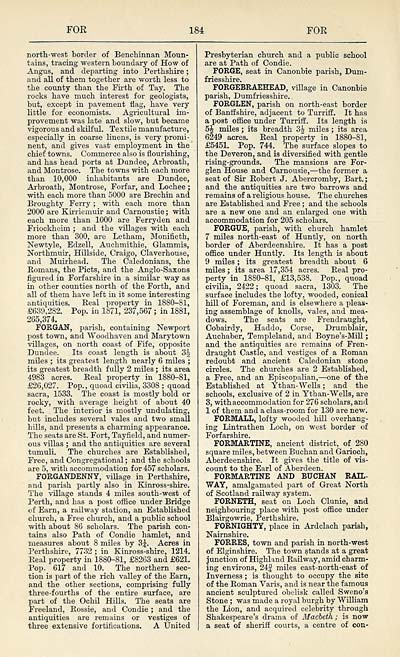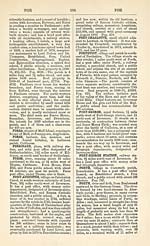Gazetteer of Scotland
(194) Page 184
Download files
Complete book:
Individual page:
Thumbnail gallery: Grid view | List view

FOE
184
FOR
north-west border of Benchinnan Moun-
tains, tracing western boundary of How of
Angus, and departing into Perthshire ;
and all of them together are worth less to
the county than the Firth of Tay. The
rocks have much interest for geologists,
but, except in pavement flag, have very
little for economists. Agricultural im-
provement was late and slow, but became
vigorous and skilful. Textile manufacture,
especially in coarse linens, is very promi-
nent, and gives vast employment in the
chief towns. Commerce also is flourishing,
and has head ports at Dundee, Arbroath,
and Montrose. The towns with each more
than 10,000 inhabitants are Dundee,
Arbroath, Montrose, Forfar, and Lochee ;
with each more than 5000 are Brechin and
Broughty Ferry ; with each more than
2000 are Kirriemuir and Carnoustie ; with
each more than 1000 are Ferryden and
Friockheim ; and the villages with each
more than 300, are Letham, Monifieth,
Newtyle, Bdzell, Auchmithie, Glammis,
Northmuir, Hillside, Craigo, Claverhouse,
and Muirhead. The Caledonians, the
Romans, the Picts, and the Anglo-Saxons
figured in Forfarshire in a similar way as
in other counties north of the Forth, and
all of them have left in it some interesting
antiquities. Real property in 1880-81,
£639,282. Pop. in 1871, 237,567 ; in 1881,
265,374.
FORGAN, parish, containing Newport
post town, and Woodhaven and Marytown
villages, on north coast of Fife, opposite
Dundee. Its coast length is about Si-
miles ; its greatest length nearly 6 miles ;
its greatest breadth fully 2 miles ; its area
4983 acres. Real property in 1880-81,
£26,027. Pop., quoad civilia, 3308 ; quoad
sacra, 1533. The coast is mostly bold or
rocky, with average height of about 40
feet. The interior is mostly undulating,
but includes several vales and two small
hills, and presents a charming appearance.
The seats are St. Fort, Tayfield, and numer-
ous villas ; and the antiquities are several
tumuli. The churches are Established,
Free, and Congregational ; and the schools
are 5, with accommodation for 457 scholars.
FORGANDENNY, village in Perthshire,
and parish partly also in Kinross-shire.
The village stands 4 miles south-west of
Perth, and has a post office under Bridge
of Earn, a railway station, an Established
church, a Free church, and a public school
with about 86 scholars. The parish con-
tains also Path of Condie hamlet, and
measures about 8 miles by 3£. Acres in
Perthshire, 7732 ; in Kinross-shire, 1214.
Real property in 1880-81, £8263 and £621.
Pop. 617 and 10. The northern sec-
tion is part of the rich valley of the Earn,
and the other sections, comprising fully
three-fourths of the entire surface, are
part of the Ochil Hills. The seats are
Freeland, Rossie, and Condie ; and the
antiquities are remains or vestiges of
three extensive fortifications. A United
Presbyterian church and a public school
are at Path of Condie.
FORGE, seat in Canonbie parish, Dum-
friesshire.
FORGEBRAEHEAD, village in Canonbie
parish, Dumfriesshire.
FORGLEN, parish on north-east border
of Banffshire, adjacent to Turriff. It has
a post office under Turriff. Its length is
5£ miles ; its breadth 2>\ miles ; its area
6249 acres. Real property in 1880-81,
£5451. Pop. 744. The surface slopes to
the Deveron, and is diversified with gentle
rising-grounds. The mansions are For-
glen House and Carnousie, — the former a
seat of Sir Robert J. Abercromby, Bart. ;
and the antiquities are two barrows and
remains of a religious house. The churches
are Established and Free ; and the schools
are a new one and an enlarged one with
accommodation for 205 scholars.
FORGUE, parish, with church hamlet
7 miles north-east of Huntly, on north
border of Aberdeenshire. It has a post
office under Huntly. Its length is about
9 miles ; its greatest breadth about 6
miles ; its area 17,354 acres. Real pro-
perty in 1880-81, £13,538. Pop., quoad
civilia, 2422; quoad sacra, 1303. The
surface includes the lofty, wooded, conical
hill of Foreman, and is elsewhere a pleas-
ing assemblage of knolls, vales, and mea-
dows. The seats are Frendraught,
Cobairdy, Haddo, Corse, Drumblair,
Auchaber, Templeland, and Boyne's-Mill ;
and the antiquities are remains of Fren-
draught Castle, and vestiges of a Roman
redoubt and ancient Caledonian stone
circles. The churches are 2 Established,
a Free, and an Episcopalian, — one of the
Established at Ythan-Wells ; and the
schools, exclusive of 2 in Ythan-Wells, are
3, with accommodation for 276 scholars, and
1 of them and a class-room for 130 are new.
FORMALL, lofty wooded hill overhang-
ing Lintrathen Loch, on west border of
Forfarshire.
FORMARTINE, ancient district, of 280
square miles, between Buchan and Garioch,
Aberdeenshire. It gives the title of vis-
count to the Earl of Aberdeen.
FORMARTINE AND BUCHAN RAIL-
WAY, amalgamated part of Great North
of Scotland railway system.
FORNETH, seat on Loch Clunie, and
neighbouring place with post office under
Blairgowrie, Perthshire.
FORNIGHTY, place in Ardclach parish,
Nairnshire.
FORRES, town and parish in north-west
of Elginshire. The town stands at a great
junction of Highland Railway, amid charm-
ing environs, 24f miles east-north-east of
Inverness ; is thought to occupy the site
of the Roman Varis, and is near the famous
ancient sculptured obelisk called Sweno's
Stone ; was made a royal burgh by William
the Lion, and acquired celebrity through
Shakespeare's drama of Macbeth ; is now
a seat of sheriff courts, a centre of con-
184
FOR
north-west border of Benchinnan Moun-
tains, tracing western boundary of How of
Angus, and departing into Perthshire ;
and all of them together are worth less to
the county than the Firth of Tay. The
rocks have much interest for geologists,
but, except in pavement flag, have very
little for economists. Agricultural im-
provement was late and slow, but became
vigorous and skilful. Textile manufacture,
especially in coarse linens, is very promi-
nent, and gives vast employment in the
chief towns. Commerce also is flourishing,
and has head ports at Dundee, Arbroath,
and Montrose. The towns with each more
than 10,000 inhabitants are Dundee,
Arbroath, Montrose, Forfar, and Lochee ;
with each more than 5000 are Brechin and
Broughty Ferry ; with each more than
2000 are Kirriemuir and Carnoustie ; with
each more than 1000 are Ferryden and
Friockheim ; and the villages with each
more than 300, are Letham, Monifieth,
Newtyle, Bdzell, Auchmithie, Glammis,
Northmuir, Hillside, Craigo, Claverhouse,
and Muirhead. The Caledonians, the
Romans, the Picts, and the Anglo-Saxons
figured in Forfarshire in a similar way as
in other counties north of the Forth, and
all of them have left in it some interesting
antiquities. Real property in 1880-81,
£639,282. Pop. in 1871, 237,567 ; in 1881,
265,374.
FORGAN, parish, containing Newport
post town, and Woodhaven and Marytown
villages, on north coast of Fife, opposite
Dundee. Its coast length is about Si-
miles ; its greatest length nearly 6 miles ;
its greatest breadth fully 2 miles ; its area
4983 acres. Real property in 1880-81,
£26,027. Pop., quoad civilia, 3308 ; quoad
sacra, 1533. The coast is mostly bold or
rocky, with average height of about 40
feet. The interior is mostly undulating,
but includes several vales and two small
hills, and presents a charming appearance.
The seats are St. Fort, Tayfield, and numer-
ous villas ; and the antiquities are several
tumuli. The churches are Established,
Free, and Congregational ; and the schools
are 5, with accommodation for 457 scholars.
FORGANDENNY, village in Perthshire,
and parish partly also in Kinross-shire.
The village stands 4 miles south-west of
Perth, and has a post office under Bridge
of Earn, a railway station, an Established
church, a Free church, and a public school
with about 86 scholars. The parish con-
tains also Path of Condie hamlet, and
measures about 8 miles by 3£. Acres in
Perthshire, 7732 ; in Kinross-shire, 1214.
Real property in 1880-81, £8263 and £621.
Pop. 617 and 10. The northern sec-
tion is part of the rich valley of the Earn,
and the other sections, comprising fully
three-fourths of the entire surface, are
part of the Ochil Hills. The seats are
Freeland, Rossie, and Condie ; and the
antiquities are remains or vestiges of
three extensive fortifications. A United
Presbyterian church and a public school
are at Path of Condie.
FORGE, seat in Canonbie parish, Dum-
friesshire.
FORGEBRAEHEAD, village in Canonbie
parish, Dumfriesshire.
FORGLEN, parish on north-east border
of Banffshire, adjacent to Turriff. It has
a post office under Turriff. Its length is
5£ miles ; its breadth 2>\ miles ; its area
6249 acres. Real property in 1880-81,
£5451. Pop. 744. The surface slopes to
the Deveron, and is diversified with gentle
rising-grounds. The mansions are For-
glen House and Carnousie, — the former a
seat of Sir Robert J. Abercromby, Bart. ;
and the antiquities are two barrows and
remains of a religious house. The churches
are Established and Free ; and the schools
are a new one and an enlarged one with
accommodation for 205 scholars.
FORGUE, parish, with church hamlet
7 miles north-east of Huntly, on north
border of Aberdeenshire. It has a post
office under Huntly. Its length is about
9 miles ; its greatest breadth about 6
miles ; its area 17,354 acres. Real pro-
perty in 1880-81, £13,538. Pop., quoad
civilia, 2422; quoad sacra, 1303. The
surface includes the lofty, wooded, conical
hill of Foreman, and is elsewhere a pleas-
ing assemblage of knolls, vales, and mea-
dows. The seats are Frendraught,
Cobairdy, Haddo, Corse, Drumblair,
Auchaber, Templeland, and Boyne's-Mill ;
and the antiquities are remains of Fren-
draught Castle, and vestiges of a Roman
redoubt and ancient Caledonian stone
circles. The churches are 2 Established,
a Free, and an Episcopalian, — one of the
Established at Ythan-Wells ; and the
schools, exclusive of 2 in Ythan-Wells, are
3, with accommodation for 276 scholars, and
1 of them and a class-room for 130 are new.
FORMALL, lofty wooded hill overhang-
ing Lintrathen Loch, on west border of
Forfarshire.
FORMARTINE, ancient district, of 280
square miles, between Buchan and Garioch,
Aberdeenshire. It gives the title of vis-
count to the Earl of Aberdeen.
FORMARTINE AND BUCHAN RAIL-
WAY, amalgamated part of Great North
of Scotland railway system.
FORNETH, seat on Loch Clunie, and
neighbouring place with post office under
Blairgowrie, Perthshire.
FORNIGHTY, place in Ardclach parish,
Nairnshire.
FORRES, town and parish in north-west
of Elginshire. The town stands at a great
junction of Highland Railway, amid charm-
ing environs, 24f miles east-north-east of
Inverness ; is thought to occupy the site
of the Roman Varis, and is near the famous
ancient sculptured obelisk called Sweno's
Stone ; was made a royal burgh by William
the Lion, and acquired celebrity through
Shakespeare's drama of Macbeth ; is now
a seat of sheriff courts, a centre of con-
Set display mode to: Large image | Transcription
Images and transcriptions on this page, including medium image downloads, may be used under the Creative Commons Attribution 4.0 International Licence unless otherwise stated. ![]()
| Gazetteers of Scotland, 1803-1901 > Gazetteer of Scotland > (194) Page 184 |
|---|
| Permanent URL | https://digital.nls.uk/97357549 |
|---|

